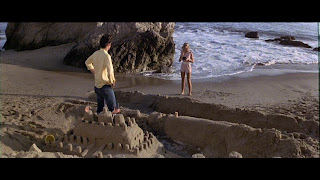In the first shot, called the long shot, we are getting a feel for the area defined as denotative meaning. Two figures are at the beach, at least that is what it looks like, and holding each other romantically while the sun is setting or rising. This scene goes immediately to a medium shot with much light.
Dr. Ramirez states that in a medium shot we are confirming what we saw from the long shot in a denotative meaning, yet on the connotative side this shot shows a relationship display. Danny is standing in the castle they have built together while Sandra Dee is taking a picture of Danny with the castle. Sounds like something a couple would do right? Exactly!
Moving to the last shot called the close up which pulls in specific information we should pay close attention to during this shot. Dr. Ramirez lectured on how during a close up shot the denotative meaning would be something we need to see and to watch for details and ask ourselves what do we need to notice here. Also, the connotative meaning underlies emotion and feelings, in this shot shows just that information. Sandra Dee looks like Danny has told her some news that she realizes is not good and her face shows her emotion.




No comments:
Post a Comment